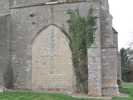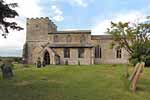For this church:    |
|
 Infilled
tower arch Infilled
tower arch |
The newer (Victorian?) infill of the arches in the tower and the north door are of hand-dressed oolitic and shelly Lincolnshire limestone, probably Ancaster Stone (Middle Jurassic age). There have been many small repairs to the original fabric using this yellow Lincolnshire limestone.
A few ironstone cobbles, possibly from the Trent, have been used as infill on the south facing chancel wall.
The roof is of Welsh slate. It was re-slated in the 1930’s, and the aisle roofs again in 1984.
The Interior
The pillars and arches are of magnesian limestone.
The floor near the entrance and in the chancel, and the steps are of Derbyshire sandstone flags.
The effigy and the reredos are of magnesian limestone.
The font is also of magnesian limestone, with decorative Derbyshire polished limestone pillars.
One of the tomb slabs in the chancel (near the vestry door and partially concealed) is of Cambrian Swithland slate from Charnwood Forest. Hardolph and Judith Wasteney’s slabs, to either side of the altar, are of polished black Carboniferous limestone, possibly from Derbyshire.
With thanks to Dr Graham Lott of British Geological Survey.






